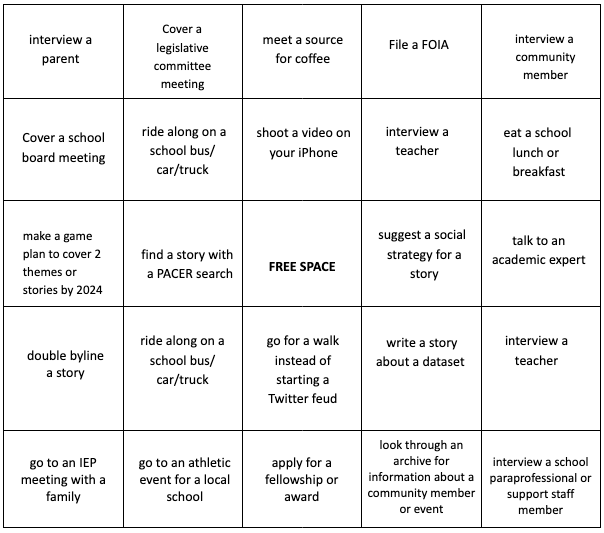You’ve launched a source tracking initiative in your newsroom. You’ve set meaningful goals.  You’ve thought through and planned how tracking sources will fit into your newsroom workflow. Yet some people in your newsroom still aren’t engaged in this project.
You’ve thought through and planned how tracking sources will fit into your newsroom workflow. Yet some people in your newsroom still aren’t engaged in this project.
Whether or not you anticipate your colleagues being on board, participation can be lackluster as you’re trying to build new habits — this isn’t unusual. I have guided a couple dozen news organizations through the onboarding and launch of source tracking projects during my time at the American Press Institute, and I’ve noticed common obstacles across the board. Most consistently: change is hard, and there are many reasons why people resist change. This week, let’s walk through some of the frequent roadblocks newsrooms encounter while tracking sources and how to build momentum when it seems like participation is lagging.
Before diving into the problems and sharing some solutions, I am going to say the quiet part out loud: It is okay if this takes longer to get off the ground than you think it will.
MANAGING ROADBLOCKS
You should anticipate it might take longer to get this initiative off the ground than you expect. There are plenty of opportunities for roadblocks. But if you plan for them, you can get ahead of them or know how to adjust. Here are a few examples with ideas for avoiding some common blocks.
Roadblock: Time
Workaround: Everyone is short on time, especially journalists. It is hard to add one more thing to an overflowing plate. For the time it takes to collect and input source tracking data, build a thoughtful workflow. For building relationships with new sources, take away something from a reporter’s schedule. Allow them time to meet with different people and don’t require them to file a story. Our partners at Alaska Public Media are doing just that: They’ve committed reporting staff to having two to five coffees quarterly with nonwhite sources. It will be a new practice for the newsroom, with the intention of building in time and freedom to strengthen new relationships.
Roadblock: Buy-in
Workaround: Getting an entire editorial team to buy into one initiative can be a challenge, even if people aren’t resistant. It’s hard to rely on the source data if it’s being tracked inconsistently, but it’s also hard to make changes to your coverage when leadership is disengaged or disinterested. You can focus on small wins first, like our partners at VTDigger in Vermont. They started this project with a short two-week period of collecting source data. From there, they used the limited data to build a presentation to the staff to set a baseline. Libbie Sparadeo, director of membership and engagement, said that one of VTDigger’s takeaways is it under-represents people from lower economic backgrounds. The initial results prompted people in the newsroom to talk about why that is and how they could change coverage. This built a launching point for more staff members to buy into the project. They set goals from there and plan on continuous source tracking to add to the dataset.
Roadblock: Other priorities
Workaround: Sometimes a source tracking project will lose steam when other priorities take their place. If this happens, try to re-engage. You can do this by offering more streamlined workflows, like our partners in Connecticut at the Record-Journal. They anticipated high engagement with source tracking because it was a continuation of additional DEIB work the organization had planned, and team members were excited to continue the work. But once they launched the project, participation lagged. Other priorities, like breaking news and daily deadlines, surfaced. Now leadership is working to re-engage. One way they’re doing this is by creating a survey form for reporters to use in the field to capture source information story by story. Another way is through more consistently talking about this project in daily and weekly meetings.
Roadblock: Breaking news
Workaround: The most well-intentioned plan can fall victim to breaking news, including source tracking. I’ve heard repeatedly that breaking news is a challenging area to consider diversifying and broadening sourcing, because you need a reliable source who will get back to you before the deadline. My advice is to plan ahead, at least where you’re able. Tell PR contacts about your goal of talking to different types of people. Ask them to be mindful of connecting you with new sources from different backgrounds. Additionally, Source Matters partner AL.com keeps an email tagline handy when reporters find themselves stuck using a repeat source. Copy, adapt and paste this tagline, from Ruth Serven Smith, education editor:
“If you are not available to speak with me on this deadline, can you recommend one or two other experts in your field who may be interested? My newsroom is always looking to expand its source list, particularly women and people of color who we may call on. Let me know if you can provide any contacts! Thanks.”
TRY IT OUT NOW
If you’re looking for more ways to engage your team in achieving source goals, Serven Smith also shared an example bingo card, as well as a blank template to recreate and adapt to fit your needs. She found this especially useful for entry-level reporters since it helps take a large task like diversifying sources and break it down into more manageable pieces. The idea is to hit “bingo” over the course of a month, and once a reporter does, she’ll take them for a treat, like to lunch. It’s a fun way to work towards goals while also boosting team morale.
“As a manager, I’m always looking for ways to encourage people to have a little more fun with their work. I’m a big fan of gamifying things when possible,” Serven Smith said.
Think through: Who are the regular stakeholders on my beat? What skills do I want to grow? What are opportunities to interview people in different settings? What are different ways to get information and story ideas?

Screenshot of a bingo card Ruth Serven Smith made for her team at AL.com to foster diversity in sourcing. Click here to access her example card, as well as a blank template to recreate and adapt to fit your needs.
DIG DEEPER
- Source Matters is accepting new partners. Register for a demo on Thursday, Oct. 12, at noon EDT, or contact us to learn more about source diversity tracking.
- If you want to start tracking sources but don’t quite know where to begin, here’s a guide to help you get started.
Share with your network
You also might be interested in:
It’s been a busy year for us: we held three API Local News Summits, built out a comprehensive guide to partnering with influencers, encouraged experiments with grants and cohorts, and supported news organizations with our products.
Today, we’re undergoing a bold transformation — reimagining ourselves as a platform that fosters generational solidarity and serves bicultural audiences from Gen Z to Boomers.
As director of inclusion and audience growth, Harris-Taylor will continue API’s efforts to drive organizational and cultural transformation while sharpening its commitment to diversity, equity, inclusion and belonging. She’ll also work to deepen API’s partnerships with community organizations and non-news experts.



